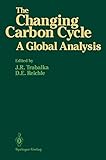The changing carbon cycle: a global analysis [Libro electrónico] / edited by John R. Trabalka, David E. Reichle
Trabalka, John R [editor] | Reichle, David E [editor/a].
Tipo de material: Libro
en línea Editor: New York, New York, United States: Springer-Verlag, c1986Descripción: xxvi, 592 páginas : ilustraciones ; 25 centímetros.ISBN: 0387962115; 9781475719178 (Print); 9781475719154 (Online).Tema(s): Ciclo del carbono (Biogeoquímica)
Libro
en línea Editor: New York, New York, United States: Springer-Verlag, c1986Descripción: xxvi, 592 páginas : ilustraciones ; 25 centímetros.ISBN: 0387962115; 9781475719178 (Print); 9781475719154 (Online).Tema(s): Ciclo del carbono (Biogeoquímica)| Tipo de ítem | Biblioteca actual | Colección | Signatura | Estado | Fecha de vencimiento | Código de barras |
|---|---|---|---|---|---|---|
| Libros | Biblioteca Electrónica Recursos en línea (RE) | Acervo General | Recurso digital | ECO400555474799 |
Incluye bibliografía e índice: páginas 575-592
1. The global atmospheric co2 distribution 1968-1983: interpretation of the results of the NOAA/GMCC measurement program.. 2. Simulating the atmospheric carbon dioxide distribution with a three-dimensional tracer model.. 3. Presentation of the 20th century atmospheric co2 record in Smithsonian spectrographic plates.. 4. Atmospheric co2 record from direct chemical measurements during the 19th century.. 5. Review of the history of atmospheric co2 recorded in ice cores.. 6. Ancient carbon cycle changes derived from tree-ring 13c and 14c.. 7. Interpretation of the northern hemispheric record of 13c/12c trends of atmospheric co2 in tree rings.. 8. Revised estimates of atmospheric co2 variations based on the tree-ring 13c record.. 9. Carbon isotope measurements in baseline air, forest canopy air, and plants.. 10. Estimating changes in the carbon content of terrestrial ecosystems from historical data.. 11. Changes in soil carbon storage and associated properties with disturbance and recovery.. 12. Continental and global scale remote sensing of land cover.. 13. Changes in the area of forests in rondonia, Amazon basin, measured by satellite imagery.. 14. One-dimensional and two-dimensional ocean models for predicting the distribution of co2 between the ocean and the atmosphere.. 15. Three-dimensional ocean models for predicting the distribution of co2 between the ocean and atmosphere.. 16. Calibrating ocean models by the constrained inverse method.. 17. Chemical and biological processes in co2-ocean models.. 18. Measurements of total carbon dioxide and alkalinity in the north Atlantic ocean in 1981.. 19. Geologic analogs: their value and limitations in carbon dioxide research.. 20. Requirements for a satisfactory model of the global carbon cycle and current status of modeling efforts.. 21. The use of observations in calibrating and validating carbon cycle models..
22. Analysis of the seasonal and geographical patterns of atmospheric co2 distributions with a three-dimensional tracer model.. 23. Fossil fuel combustion: recent amounts, patterns, and trends of co2 .. 24. Distribution and quantitative assessment of world crude-oil reserves and resources.. 25. Long-term energy projections and novel energy systems.. 26. Atmospheric co2 projections with globally averaged carbon cycle models.. 27. Possible changes in future use of fossil fuels to limit environmental effects.. Index
Disponible para usuarios de ECOSUR con su clave de acceso
The United States Government, cognizant of its responsibilities to future generations, has been sponsoring research for nine years into the causes, effects, and potential impacts of increased concentrations of carbon dioxide (C0 ) in the atmosphere. Agencies such as the National Science Foun 2 dation, National Oceanic and Atmospheric Administration, and the U.S. Department of Energy (DOE) cooperatively spent about $100 million from FY 1978 through FY 1984 directly on the study of CO • The DOE, as the 2 lead government agency for coordinating the government' s research ef forts, has been responsible for about 60% of these research efforts. William James succinctly defined our purpose when he stated science must be based upon " ... irreducible and stubborn facts." Scientific knowledge can and will reduce the present significant uncertainty sur rounding our understanding of the causes, effects, and potential impacts of increasing atmospheric CO2• We have come far during the past seven years in resolving some underlyinig doubts and in narrowing the ranges of disagreement. Basic concepts have become less murky. Yet, much more must be accomplished; more irreducible and stubborn facts are needed to reduce the uncertainties so that we can improve our knowledge base. Uncertainty can never be reduced to zero. However, with a much improved knowledge base, we will be able to learn, under stand, and be in a position to make decisions. eng
Disponible en línea
Disponible en formato PDF
Subscripción a ELSEVIER 26 de diciembre del 2013
